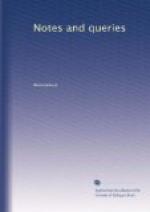“Under this stone, thir ly’th
at reste
A Friendlie Manne—A
Worthie Knight,
Whose herte and mynde was ever prest
To favour truthe—to
furder righte.
“The poore’s defense—hys
neighbors ayde,
Most kinde alwaies unto his
Kyne,
That stynt alle striffes that might be
stayed,
Whose gentil grace great love
dyd wynne,
“A Man that was fulle earneste sette
To serve hys prince at alle
assayes,
No sicknesse could him from itt lette,
Which was the shortninge of
hys daies.
“His lyf was good—he
dyed fulle welle,
Hys bodie here—the
soule in blisse;
With lengthe of wordes, why should I telle,
Or further shewe, that well
knowne is,
Since that the
teares of mor or lesse
Right welle declare
hys worthynesse.”
A.B.R.
* * * * *
QUERIES.
THE TALE OF THE WARDSTAFF.
Can any of your antiquarian correspondents furnish further elucidation of the strange ceremony of the gathering of the Wardstaff (which was in old time one of the customs of the hundred of Ongar, in Essex) than are to be found in Morant’s History of Essex, vol. i. p. 126.? from whence it was incorrectly copied in Blount’s Jocular Tenures by Beckwith, 4to. ed. It has been also more correctly given by Sir Francis Palgrave, in his Rise and Progress of the English Commonwealth, Part II. p. clvii., who justly styles it—
“a strange and uncouth fragment of the earliest customs of the Teutons; in which we can still recognise {58} the tone and the phraseology of the Courts of the Eresburg. The Irminsule itself having been described as a trunk of a tree, Thor was worshipped under the same rude symbol; and it may be suspected that the singular respect and reverence shown to the ward-staff of the East Saxons is not without its relation to the rites and ceremonies of the heathen time, though innocently and unconsciously retained.”
At the time of publication of his learned and interesting work, Sir Francis did me the honour to adopt some conjectural corrections of Morant’s very corrupt transcript of the rhyme, which I furnished at his request, in common with others suggested by the late Mr. Price. Since that time, a more mature examination of it has enabled me, I think, to put it into a form much more nearly resembling what it must have originally been; many of the corrections being obviously required by the prose details which accompany it in the MS. from which Morant gave it. It may not, therefore, be unacceptable to some of your readers, to subjoin this corrected copy. It may be proper to premise, that “The Tale of the Wardstaff” is the tallying or cutting of it, and that it was evidently originally spoken in parts, assigned as under; although it should seem that there is no indication of this arrangement in the MS.




